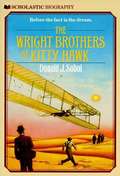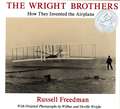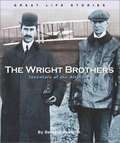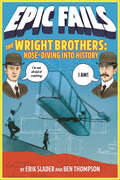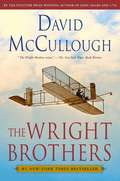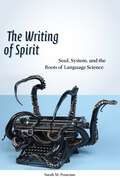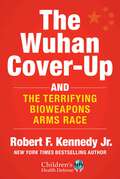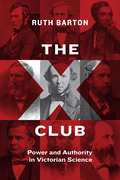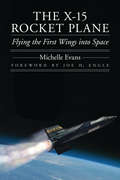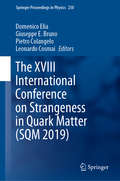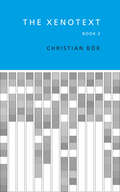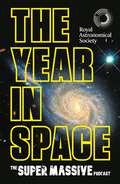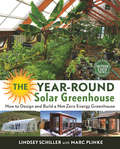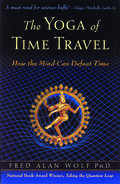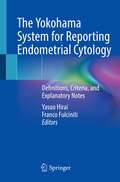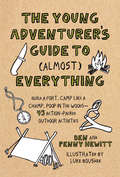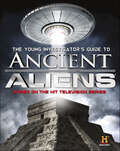- Table View
- List View
The Wright Brothers at Kitty Hawk
by Donald J. SobolAn account of Wright Brothers' work that led to the first flight at Kitty Hawk.
The Wright Brothers: How They Invented The Airplane
by Russell FreedmanHe saw the first regular airmail service introduced in 1918, the first nonstop transcontinental flight in 1923, the first round-the-world flight in 1924, the first polar flight in 1926, and the first nonstop flight across the Atlantic in 1927. He witnessed two world wars in which the airplane played a critical role. He saw the earth shrink as the jet engine replaced propellers. He lived to see airplanes that flew faster than the speed of sound, and planes whose wings stretched farther than the distance of his first flight at Kitty Hawk. There were moments when he looked back wistfully to those long-ago days when flying was still a dream that he shared with his brother. He once said, “I got more thrill out of flying before I had ever been in the air at all – while lying in bed thinking how exciting it would be to fly.”<P><P> Newbery Medal Honor book
The Wright Brothers: Inventors of the Airplane (Great Life Stories)
by Bernard Ryan Jr.The Wright Brothers were an amazing team who created one of the most revolutionary inventions of the twentieth century -- the airplane. Sons of a minister, Orville and Wilbur Wright were bright, industrious, and inseparable. As young men, they operated a print shop, published newspapers, and fixed and built bicycles. Orville and Wilbur began to actively pursue their dream of flying in the late 1890s. They built their first glider in 1900 and took it to Kitty Hawk, North Carolina, to test it. Three years later, Orville made the historic first flight on December 17. Their invention brought them much international attention. In 1909, they established the Wright American Company to build and sell their airplanes. Today, the Wright brothers are considered pioneers in the field of aviation. Book jacket.
The Wright Brothers: Nose-Diving into History (Epic Fails #1)
by Ben Thompson Erik SladerA hilarious nonfiction look at two of history's most epic "failures": the Wright brothers, whose countless crashes ultimately led to groundbreaking success.Although Orville and Wilbur Wright are celebrated today as heroes for their revolutionary contributions to science and engineering—they are acknowledged as the first men to successfully achieve powered, piloted flight—their success was hard-earned. (Spoiler alert: there were a lot of nosedives involved.) In fact, it took the self-taught engineers years of work and dozens of crashes before they managed a single twelve-second flight! In this first installment of the brand new Epic Fails series, Ben Thompson and Erik Slader take readers through the Wright brothers' many mishaps and misadventures as they paved the way for modern aviation. The Epic Fails series takes a humorous and unexpected view of history, exploring the surprising stories behind a variety of groundbreaking discoveries, voyages, experiments, and innovations, illustrating how many of mankind's biggest successes are in fact the result of some pretty epic failures.This title has Common Core connections.
The Wright Brothers: Pioneers of American Aviation
by Quentin ReynoldsA biography of the two brothers from Dayton, Ohio, who built and flew the first airplane.
The Wright Brothers: The Dramatic Story-behind-the-story
by David McCulloughThe #1 New York Times bestseller from David McCullough, two-time winner of the Pulitzer Prize—the dramatic story-behind-the-story about the courageous brothers who taught the world how to fly—Wilbur and Orville Wright.On a winter day in 1903, in the Outer Banks of North Carolina, two brothers—bicycle mechanics from Dayton, Ohio—changed history. But it would take the world some time to believe that the age of flight had begun, with the first powered machine carrying a pilot. Orville and Wilbur Wright were men of exceptional courage and determination, and of far-ranging intellectual interests and ceaseless curiosity. When they worked together, no problem seemed to be insurmountable. Wilbur was unquestionably a genius. Orville had such mechanical ingenuity as few had ever seen. That they had no more than a public high school education and little money never stopped them in their mission to take to the air. Nothing did, not even the self-evident reality that every time they took off, they risked being killed. In this “enjoyable, fast-paced tale” (The Economist), master historian David McCullough “shows as never before how two Ohio boys from a remarkable family taught the world to fly” (The Washington Post) and “captures the marvel of what the Wrights accomplished” (The Wall Street Journal). He draws on the extensive Wright family papers to profile not only the brothers but their sister, Katharine, without whom things might well have gone differently for them. Essential reading, this is “a story of timeless importance, told with uncommon empathy and fluency…about what might be the most astonishing feat mankind has ever accomplished…The Wright Brothers soars” (The New York Times Book Review).
The Writing of Spirit: Soul, System, and the Roots of Language Science
by Sarah M. PourciauContemporary thought has been profoundly shaped by the early-twentieth-century turn toward synchronic models of explanation, which analyze phenomena as they appear at a single moment, rather than diachronically as they develop through time. But the relationship between time and system remains unexplained by the standard account of this shift. Through a new history of systematic thinking across the humanities and sciences, The Writing of Spirit argues that nineteenth-century historicism wasn’t simply replaced by a more modern synchronic perspective. The structuralist revolution consisted rather in a turn toward time’s absolutely minimal conditions, and thus also toward a new theory of diachrony.Pourciau arrives at this surprising and powerful conclusion through an analysis of language-scientific theories over the course of two centuries, associated with thinkers from Jacob Grimm and Richard Wagner to the Russian Futurists, in domains as disparate as historical linguistics, phonology, acoustics, opera theory, philosophy, poetics, and psychology. The result is a novel contribution to a pressing contemporary question—namely, what role history should play in the interpretation of the present.
The Wuhan Cover-Up: And the Terrifying Bioweapons Arms Race (Children’s Health Defense)
by Robert F. Kennedy Jr.&“RFK Jr. exposes the decades of lies.&”—Luc Montagnier, Nobel laureate From the New York Times, Wall Street Journal, USA Today, and Publishers Weekly bestselling author of The Real Anthony Fauci comes an explosive exposé of the cover-up behind the true origins of COVID-19. &“Gain-of-function&” experiments are often conducted to deliberately develop highly virulent, easily transmissible pathogens for the stated purpose of developing preemptive vaccines for animal viruses before they jump to humans. More insidious is the &“dual use&” nature of this research, specifically directed toward bioweapons development. The Wuhan Cover-Up pulls back the curtain on how the US government's increase in biosecurity spending after the 2001 terror attacks set in motion a plan to transform the National Institute of Allergy and Infectious Diseases (NIAID), under the direction of Dr. Anthony Fauci, into a de facto Defense Department agency. While Dr. Fauci zealously funded and pursued gain-of-function research, concern grew among some scientists and government officials about the potential for accidental or deliberate release of weaponized viruses from labs that might trigger worldwide pandemics. A moratorium was placed on this research, but true to form, Dr. Fauci found ways to continue unperturbed—outsourcing some of the most controversial experiments offshore to China and providing federal funding to Wuhan Institute of Virology's (WIV's) leading researchers for gain-of-function studies in partnership with the Chinese military and the Chinese Communist Party. Robert F. Kennedy Jr.'s meticulously researched and rigorously sourced analysis leads readers on a staggering journey to learn about: the key enablers and henchmen pushing for gain-of-function research the economic motives behind gain-of-function research successfully engineered &“chimeric viruses&” that can infect and kill humans the coordinated effort to silence speculation of COVID-19&’s laboratory genesis the complicity of scientific journals to hide the origins of COVID-19 the role of the Wuhan Institute of Virology in China&’s biowarfare/biodefense program the relationships between US health, military, and intelligence bureaucracies and scientists and their Chinese counterparts the roles of Bill Gates and Sir Jeremy Farrar in orchestrating a global cover-up The Wuhan Cover-Up unveils a global conspiracy of epic proportion and lethal consequence.
The X Club: Power and Authority in Victorian Science
by Ruth BartonIn 1864, amid headline-grabbing heresy trials, members of the British Association for the Advancement of Science were asked to sign a declaration affirming that science and scripture were in agreement. Many criticized the new test of orthodoxy; nine decided that collaborative action was required. The X Club tells their story. These six ambitious professionals and three wealthy amateurs—J. D. Hooker, T. H. Huxley, John Tyndall, John Lubbock, William Spottiswoode, Edward Frankland, George Busk, T. A. Hirst, and Herbert Spencer—wanted to guide the development of science and public opinion on issues where science impinged on daily life, religious belief, and politics. They formed a private dining club, which they named the X Club, to discuss and further their plans. As Ruth Barton shows, they had a clear objective: they wanted to promote “scientific habits of mind,” which they sought to do through lectures, journalism, and science education. They devoted enormous effort to the expansion of science education, with real, but mixed, success. For twenty years, the X Club was the most powerful network in Victorian science—the men succeeded each other in the presidency of the Royal Society for a dozen years. Barton’s group biography traces the roots of their success and the lasting effects of their championing of science against those who attempted to limit or control it, along the way shedding light on the social organization of science, the interactions of science and the state, and the places of science and scientific men in elite culture in the Victorian era.
The X in Sex: How the X Chromosome Controls Our Lives
by David BainbridgeA tiny scrap of genetic information determines our sex; it also consigns many of us to a life of disease, directs or disrupts the everyday working of our bodies, and forces women to live as genetic chimeras. The culprit--so necessary and yet the source of such upheaval--is the X chromosome, and this is its story. An enlightening and entertaining tour of the cultural and natural history of this intriguing member of the genome, The X in Sex traces the journey toward our current understanding of the nature of X. From its chance discovery in the nineteenth century to the promise and implications of ongoing research, David Bainbridge shows how the X evolved and where it and its counterpart Y are going, how it helps assign developing human babies their sex--and maybe even their sexuality--and how it affects our lives in infinitely complex and subtle ways. X offers cures for disease, challenges our cultural, ethical, and scientific assumptions about maleness and femaleness, and has even reshaped our views of human evolution and human nature.
The X-15 Rocket Plane: Flying the First Wings into Space (Outward Odyssey: A People's History of Spaceflight)
by Michelle EvansWith the Soviet Union&’s launch of the first Sputnik satellite in 1957, the Cold War soared to new heights as Americans feared losing the race into space. The X-15 Rocket Plane tells the enthralling yet little-known story of the hypersonic X-15, the winged rocket ship that met this challenge and opened the way into human-controlled spaceflight.Drawing on interviews with those who were there, Michelle Evans captures the drama and excitement of, yes, rocket science: how to handle the heat generated at speeds up to Mach 7, how to make a rocket propulsion system that could throttle, and how to safely reenter the atmosphere from space and make a precision landing.This book puts a human face on the feats of science and engineering that went into the X-15 program, many of them critical to the development of the Space Shuttle. And, finally, it introduces us to the largely unsung pilots of the X-15. By the time of the Apollo 11 moon landing, thirty-one American astronauts had flown into space—eight of them astronaut-pilots of the X-15. The X-15 Rocket Plane restores these pioneers, and the others who made it happen, to their rightful place in the history of spaceflight.Browse more spaceflight books at upinspace.org. Purchase the audio edition.
The XVIII International Conference on Strangeness in Quark Matter (Springer Proceedings in Physics #250)
by Domenico Elia Giuseppe E. Bruno Pietro Colangelo Leonardo CosmaiThis book focuses on new experimental and theoretical advances concerning the role of strange and heavy-flavour quarks in high-energy heavy-ion collisions and in astrophysical phenomena. The topics covered include • Strangeness and heavy-quark production in nuclear collisions and hadronic interactions, • Hadron resonances in the strongly-coupled partonic and hadronic medium, • Bulk matter phenomena associated with strange and heavy quarks, • QCD phase structure, • Collectivity in small systems, • Strangeness in astrophysics,• Open questions and new developments.
The Xenotext: Book 2
by Christian BokThe first work of ‘living poetry’ in the world, by the author of the bestselling book Eunoia.Christian Bök in Book 1 of The Xenotext outlined his plan to encode a poem into the genome of a deathless bacterium, thereby writing a text durable enough to outlive any apocalypse, surviving until the death of the Sun itself. After more than two decades of effort, Bök has, at last, succeeded at this incredible experiment, and Book 2 of The Xenotext situates his enterprise within the deep time of the cosmos.Bök rehearses some of the techniques likely to be used in the future to preserve the cultural heritage of our civilization against a potential planetary disaster (be it thermonuclear warfare or astrophysical barrage); moreover, Bök speculates that, buried within the biochemistry of Life itself, there really does exist an innate beauty, if not a hidden poetry – a literal message that we might read, if we deign to seek it.
The Yamuna River Basin
by Vijay P. Singh Alka Upadhyay C. Shekhar Ojha Raveendra Kumar RaiThis book is designed to provide concepts, methodologies, and approaches for river basin studies with respect to water resources and environment. The book is not limited to the Yamuna River basin, but will help in the study of various other river basins for integrated water resources management. The book covers the essential components of integrated water resources management, including analysis of climatic variables, climate change detection, analysis of natural resources, geology, geomorphology, socio-economics, water budgeting, flood estimation, river pollution, etc. Furthermore, the book addresses recent issues pertaining to water quality, water quality indices, environmental flows, water resources management through cropping pattern change, etc. along with methodologies and application to the Yamuna River system. However, the main objective of this book is to address important issues of water resources management of river basins. Audience: The manuscript has been designed so that it can be used as a reference for river basin studies. The book will be useful to engineers, agricultural scientists, environmentalists, planners, managers, and administrators who are concerned with water resources.
The Year in Space: From the makers of the number-one space podcast, in conjunction with the Royal Astronomical Society
by The Supermassive Podcast (Izzie Clarke, Dr Becky Smethurst, Richard Hollingham and Robert Massey)Is it possible for humans to live on other planets?What will happen on the next mission to the Moon?And was there really once life on Mars?Brought to you by the infectiously enthusiastic team behind The Supermassive Podcast from the Royal Astronomical Society, The Year in Space highlights the most exciting space news from the past twelve months and looks forward to the year ahead. Packed with features, interviews, in-depth explainers and stunning photography, it covers everything from the extraordinary new images from the James Webb telescope to the search for extraterrestrial life. You'll also find practical tips on what to look out for in the night sky in 2023. Fun, engaging and accessible, this is essential reading for every space enthusiast.
The Year in Space: From the makers of the number-one space podcast, in conjunction with the Royal Astronomical Society
by The Supermassive Podcast (Izzie Clarke, Dr Becky Smethurst, Richard Hollingham and Robert Massey)Is it possible for humans to live on other planets?What will happen on the next mission to the Moon?And was there really once life on Mars?Brought to you by the infectiously enthusiastic team behind The Supermassive Podcast from the Royal Astronomical Society, The Year in Space highlights the most exciting space news from the past twelve months and looks forward to the year ahead. Packed with features, interviews, in-depth explainers and stunning photography, it covers everything from the extraordinary new images from the James Webb telescope to the search for extraterrestrial life. You'll also find practical tips on what to look out for in the night sky in 2023. Fun, engaging and accessible, this is essential reading for every space enthusiast.
The Year of the Intern
by Robin CookThe nurse is desperate. "Dr. Peters, the patient has stopped breathing and he doesn't have any pulse." "I'm on my way." Dr. Peters, in his fifteenth day of internship, is running again. True, he has been trained to run, through high school, the Ivy League, and a prestigious eastern medical school. Now he has run all the way to Hawaii for his year as an intern. He has run away from the pressure and competition of the mainland medical system. He is tired-tired and scared. And with good reason. After two weeks on call, his exhausted nervous system is in rebellion. Worse yet, three years of the best medical training this country has to offer have taught him too little of practical value. He knows less than a nurse about medication; his surgical knots won't hold; all his knowledge about Schwartzman reaction and other esotérica is useless in the practical hurly-burly of daily hospital life. As for the man who has stopped breathing- "What time did he die?" Peters asks the nurse. "He died when you pronounced him dead, Doctor." Some parts of Hawaii do not disappoint. The climate and the girls are joyful. But in his attempt to grow as a doctor, Peters on his own. As posstesor of a medical degree he is called "Doctor" he is a stage prop, a human mechanism holding retractors through endless operations, staring at the back of the surgeon, unable to see, to learn. On the ward, senior doctors see to it that Peters does the work-ups-fills out charts, draws blood, the "scut" work-and handles night calls. Thus Peters alternates between frustrating days and panic-filled nights. In the emergency room it is much the same. Amid the banality of common colds, backaches, and surfing lacerations, Peters delivers a baby, handles the multiple wreckage of an automobile accident, and deals as best he can with patients who need years of psychiatric care rather than a few hurried minutes with an intern.
The Year-Round Solar Greenhouse: How to Design and Build a Net-Zero Energy Greenhouse
by Lindsey Schiller Marc PlinkeComprehensive coverage of passive solar greenhouse design including material selection, building methods and how to store thermal energy using a variety of simple and innovative strategies. Over a dozen case studies provide real-life inspiration, capped off with how-to guidance for building a durable, energy-efficient greenhouse. Variations include underground and aquaponic greenhouses and integrating solar panels to grow off-grid, year-round.
The Yoga Science
by Divyansh SharmaEmbark on a transformative journey through yoga with this comprehensive guide, which beautifully blends ancient wisdom with modern science. Exploring fascinating topics like calorie burn, injury prevention, muscle strength, and bio-individuality, the book reveals how yoga surpasses conventional exercise in functionality and safety. The Yoga Science serves as an invaluable resource for both seasoned practitioners and beginners, enhancing your practice while deepening your appreciation for the timeless wisdom of yoga.Discover the evidence-backed secrets of yoga, with over 50 asanas thoughtfully categorised into 10 distinct types, from foundational to advanced poses. Each asana includes essential details, such as unique attributes, and benefits for various organ systems, targeted areas, and major muscles, along with step-by-step techniques, complete with modifications for all abilities.Rooted in both yogic scriptures and contemporary science, this complete guide offers a fresh perspective on how yoga can empower your body, mind, and soul—tailored to meet your personal needs and goals.What You&’ll Find Inside:• The History of Yoga: Uncover the birthplace of yoga and how it evolved over centuries.• The Meaning of Yoga: More than just stretching! Learn what yoga truly means and its different definitions.• Beginner&’s Guide: Start your yoga journey with the basics—place, equipment, and best practices.• Dimensions of Health: Explore the WHO and yogic perspectives on health.• Alignment & Asanas: Dive into the science of movement and master 50+ asanas with ease.• Biomechanics Breakdown: Learn how your body works through each pose with a fun take on organ systems and joint angles.Plus! A special chapter on tackling common yoga questions and debunking popular myths (no, it won&’t make you taller!).
The Yoga of Time Travel
by Fred Alan WolfTime travel is not just science fiction; it may actually be possible. Wolf draws on yoga and quantum physics to show that time is a flexible projection of mind. Cheating time, he says, is an ancient metaphysical idea from the Vedas having to do with moving through meditation to a place where time stands still.
The Yoga of Time Travel
by Ph.D. Fred Alan WolfBuddha said he could move backward through time, observes theoretical physicist Fred Alan Wolf. Time travel is not just science fiction; it may actually be possible. Wolf draws on yoga and quantum physics to show that time is a flexible projection of mind. Cheating time, he says, is an ancient metaphysical idea from the Vedas having to do with moving through meditation to a place where time stands still.In reader-friendly language, Wolf explores how time and thought are bound together and how a change in ego structure could allow freedom from time's limitations. And he elaborates on benefits: Time travel, he asserts, could clarify our purpose; change our sense of self, the future, and death; and provide a hero's journey that might aid the entire community. Fascinatingly, Wolf thinks that, under certain circumstances, we might not only visit but even alter the past, with a ripple effect on the present.
The Yokohama System for Reporting Endometrial Cytology: Definitions, Criteria, and Explanatory Notes
by Yasuo Hirai Franco FulcinitiThis book describes a standardized method for classifying and reporting invasive endometrial malignancies via direct endometrial sampling. Featuring a wealth of color illustrations, it provides specific diagnostic categories and cytomorphologic criteria to promote uniform and reliable diagnoses. It also describes the history of directly sampled endometrial cytology, reviews the sampling techniques and algorithmic approach, discusses specimen adequacy, and outlines challenges for the future. The Yokohama System for Reporting Endometrial Cytology – Definitions, Criteria and Explanatory Notes offers a valuable resource for researchers at clinical cytopathological laboratories around the world whose work involves gynecological cytology, oncology, pathology, and cytopathology. It will also appeal to researchers in the fields of cytotechnology, basic science, pathology and related industries, medical residents and clinicians.
The Young Adventurer's Guide to (Almost) Everything: Build a Fort, Camp Like a Champ, Poop in the Woods-45 Action-Packed Outdoor Activities
by Ben Hewitt45 step-by-step, illustrated activties that teach kids everything from how to see like an owl to build the world's coolest fort from sticks. (ages 8-12)Calling all adventurers! Want to know how to build a fort from nothing but sticks? Or find your way through the forest? This survival guide is your ticket to getting down and dirty in nature and learning to make the coolest things with your own two hands. Look inside to learn how to: • Use a knife without bleeding • Sleep in the woods without freezing • Escape a bear without getting eaten • Poop in the woods without falling down • Find your way home without a GPS • Eat bugs without throwing up • And so much more!
The Young Investigator's Guide to Ancient Aliens
by History ChannelAs a tie-in to the wildly successful History Channel show, here's a book filled with fascinating tales, ancient folklore, and compelling evidence of the role extraterrestrials may have played in human history. What really happened to the dinosaurs? Who actually built the ancient pyramids in Egypt? Are airplanes really as modern as we think they are? This book takes a close look at landmark events throughout history and asks the question: What if aliens were involved? Spanning history, from the earliest of human civilizations to the modern period, this book exposes evidence of the presence of extraterrestrials in some of our most triumphant and devastating moments.
The Youngest Science: Notes of a Medicine-Watcher
by Lewis ThomasFrom the 1920s when he watched his father, a general practitioner who made housecalls and wrote his prescriptions in Latin, to his days in medical school and beyond, Lewis Thomas saw medicine evolve from an art into a sophisticated science. The Youngest Science is Dr. Thomas's account of his life in the medical profession and an inquiry into what medicine is all about--the youngest science, but one rich in possibility and promise.He chronicles his training in Boston and New York, his war career in the South Pacific, his most impassioned research projects, his work as an administrator in hospitals and medical schools, and even his experiences as a patient. Along the way, Thomas explores the complex relationships between research and practice, between words and meanings, between human error and human accomplishment, More than a magnificent autobiography, The Youngest Science is also a celebration and a warning--about the nature of medicine and about the future life of our planet.
